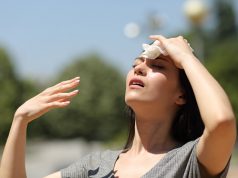Vitiligo is a condition that often sees its victims stigmatized and shunned. In a recent portrayal of a vitiligo sufferer, Jamila Awad delivers an emotive performance bound to open some eyes and hearts.
To get a more inside look into this elusive condition, we talked with leading Cairo dermatologist, Dr. Mohamed Mongy.
CW: Dr. Mongy, what causes vitiligo?
MM: This is a condition in which depigmentation occurs to the skin. In the skin, cells called melanocytes produce the pigment that gives the skin its color. Melanin is the pigment produced by melanocytes. It provides pigmentation for skin, hair, and eyes. When the melanocytes are destroyed, skin cells appear white, and this causes vitiligo.
What are the indications of vitiligo?
Irregular white patches may occur on any area of the body. The condition can also have an effect on mucous membranes, the retina of the eye, as well as the scalp, where hair growth in the affected area may turn white. It affects 1% to 2% of the population and can affect anyone.
Do special precautions need to be taken?
Melanin plays a strong role in protecting the skin from the sun. A lack of pigmentation in the skin due to vitiligo leads to a greater risk of sun sensitivity in affected areas, increasing the chance of sunburn and the possible development of skin cancer in people with the condition.
No methods prevent vitiligo, but using sunscreens with a minimum sun protection factor of SPF 15 to protect your skin from the sun is always a healthy decision.
Which parts of the body are generally affected?
Affected parts may be in similar areas of both sides of the body, particularly the hands, elbows, knees and axillae. It also occurs around the mouth, eyes and genitalia.
Is vitiligo hereditary?
Yes, it can be. Persons with positive family Hx are more prone. Vitiligo is more frequent in families with a positive history of the condition. It is also evident in disorders of the immune system and has been linked to pernicious anemia, hyperthyroidism and Addison’s disease. It is also common with thyroid gland dysfunction, diabetes, alopecia areata and other conditions with autoimmune disease.
Is it more common in males or females?
Both males and females are equally affected. Females are generally more concerned and present to clinics earlier.

Can vitiligo be treated?
Yes, there are different modes of treatment starting with topical medications, phototherapy, Excimer 308 laser treatments, skin grafting and even individual cell harvesting. These have varying levels of success and should be undertaken with the help of a medical specialist.
What is the most effective way to cover the white patches?
- Waterproof makeup is available in many different colors to match many different skin tones. This is a good choice to effectively cover affected white patches and is safe for everyone, including children.
- Stains may be useful to dye the skin a color that more closely matches the unaffected areas. Certain self-tanning products contain dihydroxyacetone, which produces a tan and does not require the melanocytes in the skin to produce melanin. The tan fades over time and must be repeated.
- Micropigmentation tattooing is useful for small white patches associated with vitiligo. This method also adds color to the white patch.
Does the condition get worse with age?
It normally progresses with age if left untreated.
Should people be concerned about catching vitiligo? Is it contagious?
Definitely not. It cannot transmit from person to person.
How can public awareness of the condition be improved?
There are support groups for vitiligo, mostly self-funded and non-governmental. Celebrity endorsements, such as the recent TV episodes, Lazem Aesh, from the series Ela Ana, where Jamila Awad plays a very important role in debunking the myths associated with the condition.
With increased public awareness, hurtful discrimination should soon become a thing of the past.
Wear Your Skin! Not a Mask: Achieve an All-Natural Look with Make-up





